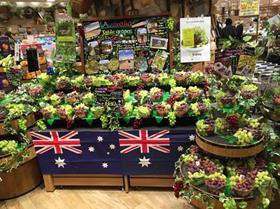
Sweet, seedless and easy to eat: it’s the combination that consumers are after in Japan and one that bodes well for Australia’s table grape industry.
“Ten years ago, Japanese consumers didn’t eat many grapes, or any fruit with the skin on. The market didn’t accept imported grapes, but now, we’re seeing that market grow,” Jack Moriya of leading wholesaler and importer Tokyo Seika said. “The younger generation don’t have that resistance to eating fruit with the skin on.”
With a shorter shipping time compared to other Southern Hemisphere suppliers, Australia has an added advantage in terms of freshness, not to mentioned the reduced tariffs on table grapes off the back of the Japan-Australia Free Trade Agreement (JAEPA).
Access to Japan for fresh Australian table grapes was granted ahead of the 2014 season, and since JAEPA came into force in January 2015, the tariff on grapes shipped from 1 November through the end of February dropped to 5.9 per cent and will continue to fall year by year until grapes are duty free from 1 April 2021.
“Japan is shaping up to be an important market as Japanese retailers and wholesalers seek high-quality, sweet-flavoured seedless Australian grapes for their growing consumers market,” explained Jeff Scott, CEO of the Australian Table Grape Association.
Sales of table grapes in the first six months of 2015 reached A$6.5m, Scott said, with the projected export value for the 2016 season at A$20m.
“This growth is only projected to continue as Japan becomes Australia’s second-biggest trading partner after China,” Scott added.
Leading a delegation of Australian table grape shippers to Japan in December 2015, Scott said that one of the major lessons learnt from visiting importers and retailers is that taste is the determining factor for consumers.
In-store tastings and retail promotions have proven effective in introducing new products into the market – a move that also worked for the Australian citrus industry which has found consumers in Japan are willing to pay more for the eating quality and taste of Australian citrus compared to cheaper fruit sourced from other countries.
And, with the absence of table grapes promotions from competing suppliers such as Chile or South Africa, Australian shippers have much to gain from promoting their produce.
This season, Masahiro Sumiya, managing director of leading importer Kobe Yoko, expects shipments to Japan to almost double that of 2015.
“Japan can take that volume,” Sumiya said, adding that as importers and consumers are becoming aware of the eating quality of Australian grapes, there has been a decrease in shipments from Chile.
Red Globes are the outlier, though, with cheaper produce from Chile continuing to trump sales of Australian Red Globes.
Doug Hammond of Australian-based fresh produce company Valleyfresh explained that the demand from Japan has been primarily for Thompson and Crimson seedless, with Valleyfresh hoping to ship 30 containers or more to Japan this season.
Speaking to Fruitnet in December, Hammond said that several years ago Australians were pulling up Thompson plantations due to low market prices and high labour inputs. Now, on the back of rising demand from Japan, there has been a resurgence in Thompson plantations, though it will be a few more years before these new plantations have a full crop for harvest.
Broader opportunities emerge
JAEPA hasn’t just offered hope for table grape exporters, though, with Australian fresh fruit and vegetable shippers to benefit from reduced tariffs on a range of products.
Catherine Taylor, senior trade commissioner for Austrade in Osaka, Japan, told Fruitnet that Australia’s agriculture industry has huge potential in Japan, where the food self-sufficiency rate on a calorific basis lingers around 39 per cent, according to Japan’s Ministry of Agriculture, Forestry and Fisheries. In comparison, Australia’s food self-sufficiency is about 205 per cent, with potential to grow.
“For Australia, as trusted suppliers of essential food, this means ongoing business opportunities,” Taylor explained. “With the implementation of preferential tariff rates under JAEPA, now is the time to review the depth and quality of the opportunity that the market holds for Australian exporters. It is pleasing to see that other products benefit under JAEPA as well.'
Since the implementation of JAEPA, sales of shelled almonds to Japan have increased from A$0.4m to A$4.1m, while asparagus sales have increased 41 per cent, according to Australian minister of trade Andrew Robb.
“A key to long-term success in Japan is understanding the market and consumer preferences, and responding with consistent product quality,” Taylor says, adding that clever promotions and investments in market development are needed in order to gain market share.
“In the short-term, JAEPA has put Australian horticultural products back in the spotlight among importers and consumers,” Taylor said. “Japan will always be one of the world’s largest net importers of food, and therefore, a key market for Australia.”
The February issue of Asiafruit Magazine is out now, featuring an in-depth look at the fresh produce market in Japan






No comments yet